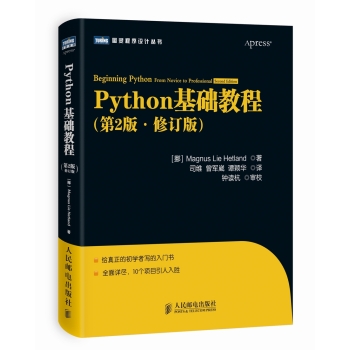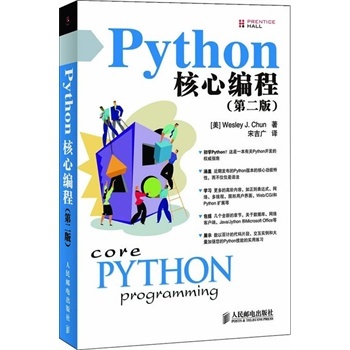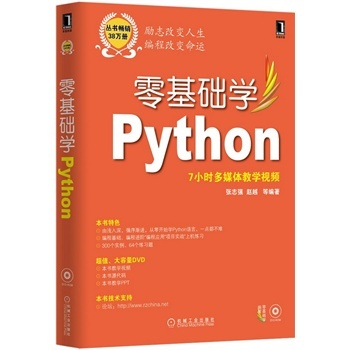这里有许许多多本书不同语言的译本,感谢那些不知疲倦的志愿者们!
如果你想帮助这些译本,请参看下面的关于志愿者和语言的列表,然后决定是要开始一个新的翻译项目还是帮助改进现有的翻译项目。
如果你计划开始一个新的翻译项目,请参阅如何翻译.
阿拉伯语
Here is the link for the Arabic version , Thanks for Ashraf Ali Khalaf for translating the book , you can read the whole book online here or you can download it
from here:download Source-forge
for more info click here
巴西葡萄牙语
Rodrigo Amaral (rodrigoamaral-at-gmail-dot-com) has volunteered to translate the book to Brazilian Portuguese…
加泰罗尼亚语
Moises Gomez (moisesgomezgiron-at-gmail-dot-com) has volunteered to translate the book to Catalan.
The translation is in progress, and starts with the chapter “Taula de continguts”.
Moisès Gómez – I am a developer and also a teacher of programming (normally for people without any previous experience).
Some time ago I needed to learn how to program in Python, and Swaroop’s work was really helpful. Clear, concise, and complete enough. Just what I needed.
After this experience, I thought some other people in my country could take benefit from it too. But English language can be a barrier.
So, why not try to translate it? And I did for a previous version of BoP.
I my country there are two official languages. I selected the Catalan language assuming that others will translate it to the more widespread Spanish.
中文
Here’s a Chinese version at Python_cn:Table_of_Contents.
Juan Shen (orion-underscore-val-at-163-dot-com) has volunteered to translate the book to Chinese.
It is available at http://www.pycn.org/python%E5%9C%A8%E7%BA%BF%E6%89%8B%E5%86%8C
what? – I am a postgraduate at Wireless Telecommunication Graduate School, Beijing University of Technology, China PR. My current research interest is on the synchronization, channel estimation and multi-user detection of multicarrier CDMA system. Python is my major programming language for daily simulation and research job, with the help of Python Numeric, actually. I learned Python just half a year before, but as you can see, it’s really easy-understanding, easy-to-use and productive. Just as what is ensured in Swaroop’s book, ‘It’s my favorite programming language now’.
‘A Byte of Python’ is my tutorial to learn Python. It’s clear and effective to lead you into a world of Python in the shortest time. It’s not too long, but efficiently covers almost all important things in Python. I think ‘A Byte of Python’ should be strongly recommendable for newbies as their first Python tutorial. Just dedicate my translation to the potential millions of Python users in China.
繁体中文
Fred Lin (gasolin-at-gmail-dot-com) has volunteered to translate the book to Chinese Traditional.
It is available at http://code.google.com/p/zhpy/wiki/ByteOfZhpy.
An exciting feature of this translation is that it also contains the executable chinese python sources side by side with the original python sources.
Fred Lin – I’m working as a network firmware engineer at Delta Network, and I’m also a contributor of TurboGears web framework.
As a python evangelist (:-p), I need some material to promote python language. I found ‘A Byte of Python’ hit the sweet point for both newbies and experienced programmers. ‘A Byte of Python’ elaborates the python essentials with affordable size.
The translation are originally based on simplified chinese version, and soon a lot of rewrite were made to fit the current wiki version and the quality of reading.
The recent chinese traditional version also featured with executable chinese python sources, which are achieved by my new ‘zhpy’ (python in chinese) project (launch from Aug 07).
zhpy(pronounce (Z.H.?, or zippy) build a layer upon python to translate or interact with python in chinese(Traditional or Simplified). This project is mainly aimed for education.
法语
Gregory (coulix-at-ozforces-dot-com-dot-au) has volunteered to translate the book to French.
Gérard Labadie (Palmipede) has completed to translate the book to French, it starts with http://www.swaroopch.com/notes/Python_fr:Table_des_Matières
德语
Lutz Horn (lutz-dot-horn-at-gmx-dot-de), Bernd Hengelein (bernd-dot-hengelein-at-gmail-dot-com) and Christoph Zwerschke (cito-at-online-dot-de) have volunteered to translate the book to German.
Their translation is located at http://abop-german.berlios.de.
Lutz Horn: I’m 32 years old and have a degree of Mathematics from University of Heidelberg, Germany. Currently I’m working as a software engineer on a publicly funded project to build a web portal for all things related to computer science in Germany.
The main language I use as a professional is Java, but I try to do as much as possible with Python behind the scenes. Especially text analysis and conversion is very easy with Python. I’m not very familiar with GUI toolkits, since most of my programming is about web applications, where the user interface is build using Java frameworks like Struts. Currently I try to make more use of the functional programming features of Python and of generators. After taking a short look into Ruby, I was very impressed with the use of blocks in this language. Generally I like the dynamic nature of languages like Python and Ruby since it allows me to do things not possible in more static languages like Java.
I’ve searched for some kind of introduction to programming, suitable to teach a complete non-programmer. I’ve found the book ‘How to Think Like a Computer Scientist: Learning with Python’, and ‘Dive into Python’. The first is good for beginners but to long to translate. The second is not suitable for beginners. I think ‘A Byte of Python’ falls nicely between these, since it is not too long, written to the point, and at the same time verbose enough to teach a newbie. Besides this, I like the simple DocBook structure, which makes translating the text a generation the output in various formats a charm.
Bernd Hengelein: Lutz and me are going to do the german translation together. We just started with the intro and preface but we will keep you informed about the progress we make.
Ok, now some personal things about me. I am 34 years old and playing with computers since the 1980′s, when the “Commodore C64″ ruled the nurseries. After studying computer science I started working as a software engineer. Currently I am working in the field of medical imaging for a major german company. Although C++ is the main language I (have to) use for my daily work, I am constantly looking for new things to learn.
Last year I fell in love with Python, which is a wonderful language, both for its possibilities and its beauty. I read somewhere in the net about a guy who said that he likes python, because the code looks so beautiful. In my opinion he’s absolutly right. At the time I decided to learn python, I noticed that there is very little good documentation in german available. When I came across your book the spontaneous idea of a german translation crossed my mind. Luckily, Lutz had the same idea and we can now divide the work.
I am looking forward to a good cooperation!
希腊语
The Greek Ubuntu Community translated the book in Greek, for use in our on-line asynchronous Python lessons that take place in our forums.
印尼语
Daniel (daniel-dot-mirror-at-gmail-dot-com) is translating the book to Indonesian at http://python.or.id/moin.cgi/ByteofPython
W. Priyambodo also has volunteered to translate the book to Indonesian. The translation is in progress and here is the table of contents.
意大利语
Enrico Morelli (mr-dot-mlucci-at-gmail-dot-com) and Massimo Lucci (morelli-at-cerm-dot-unifi-dot-it) have volunteered to translate the book to Italian.
The Italian translation is present at www.gentoo.it/Programmazione/byteofpython. The new translation is in progress and start with “Prefazione”.
Massimo Lucci and Enrico Morelli – we are working at the University of Florence (Italy) – Chemistry Department. I (Massimo) as service engineer and system administrator for Nuclear Magnetic Resonance Spectrometers; Enrico as service engineer and system administrator for our CED and parallel / clustered systems. We are programming on python since about seven years, we had experience working with Linux platforms since ten years. In Italy we are responsible and administrator for www.gentoo.it web site for Gentoo/Linux distrubution and www.nmr.it (now under construction) for Nuclear Magnetic Resonance applications and Congress Organization and Managements.
That’s all! We are impressed by the smart language used on your Book and we think this is essential for approaching the Python to new users (we are thinking about hundred of students and researcher working on our labs).
蒙古语
Ariunsanaa Tunjin (luftballons2010-at-gmail-dot-com) has volunteered to translate the book to Mongolian.
- Update on Nov 22, 2009: Ariunsanaa is on the verge of completing the translation.
挪威博克马尔文
Eirik Vågeskar (or Vages) is a high school student at Sandvika videregående skole in Norway, a blogger and currently translating the book to Norwegian (bokmål). The translation is in progress, and you can check the table of contents for more details.
Eirik Vågeskar: I have always wanted to program, but because I speak a small language, the learning process was much harder. Most tutorials and books are written in very technical English, so most high school graduates will not even have the vocabulary to understand what the tutorial is about. When I discovered this book, all my problems were solved. “A Byte of Python” used simple non-technical language to explain a programming language that is just as simple, and these two things make learning Python fun. After reading half of the book, I decided that the book was worth translating. I hope the translation will help people who have found themself in the same situation as me (especially young people), and maybe help spread interest for the language among people with less technical knowledge.
波兰文
Dominik Kozaczko (dkozaczko-at-gmail-dot-com) has volunteered to translate the book to Polish. Translation is in progress and it’s main page is available here: Ukąś Pythona.
Update: The translation is complete and ready as of Oct 2, 2009. Thanks to Dominik, his two students and their friend for their time and effort!
Dominik Kozaczko – I’m a Computer Science and Information Technology teacher.
葡萄牙语
Fidel Viegas (fidel-dot-viegas-at-gmail-dot-com) has volunteered to translate the book to Portuguese.
罗马尼亚语
Paul-Sebastian Manole (brokenthorn-at-gmail-dot-com) has volunteered to translate this book to Romanian.
Paul-Sebastian Manole – I’m a second year Computer Science student at Spiru Haret University, here in Romania. I’m more of a self-taught programmer and decided to learn a new language, Python. The web told me there was no better way to do so but read A Byte of Python. That’s how popular this book is (congratulations to the author for writing such an easy to read book). I started liking Python so I decided to help translate the latest version of Swaroop’s book in Romanian. Although I could be the one with the first initiative, I’m just one volunteer so if you can help, please join me.
The translation is being done here.
俄语 & 乌克兰语
Averkiev Andrey (averkiyev-at-ukr-dot-net) has volunteered to translate the book to Russian, and perhaps Ukranian (time permitting).
西班牙语
Alfonso de la Guarda Reyes (alfonsodg-at-ictechperu-dot-net), Gustavo Echeverria (gustavo-dot-echeverria-at-gmail-dot-com) and David Crespo Arroyo (davidcrespoarroyo-at-hotmail-dot-com) have volunteered to translate the book to Spanish. The translation is in progress, you can read the spanish (argentinian) translation starting by the table of contents (tabla de contenidos).
Gustavo Echeverria: I work as a software engineer in Argentina. I use mostly C# and .Net technologies at work but strictly Python or Ruby in my personal projects. I knew Python many years ago and I got stuck inmediately. Not so long after knowing Python I discovered this book and it helped me to learn the language. Then I volunteered to translate the book to Spanish. Now, after receiving some requests, I’ve begun to translate “A Byte of Python” with the help of Maximiliano Soler.
瑞典语
Mikael Jacobsson (leochingkwake-at-gmail-dot-com) has volunteered to translate the book to Swedish.
土耳其语
Türker SEZER (tsezer-at-btturk-dot-net) and Bugra Cakir (bugracakir-at-gmail-dot-com) have volunteered to translate the book to Turkish.
- 注意
- 本页之前提到的电邮地址中,用 '@' 替换 '-at-','.' 替换 '-dot-' ,'_' 替换 '-underscore-'。Dashes in other places in the email address remain as-is.



